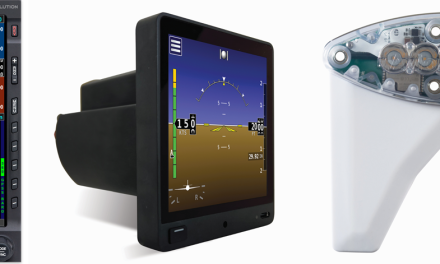Conspicuity
DEFINITION 1. noun form of conspicuous con·spic·u·ous
ADJECTIVE
1. standing out so as to be clearly visible:
I’ve written six articles on ADS-B, my first article in February 2015. A certain amount of research went into those articles; after all, if my articles aren’t accurate, they’re not worth reading. My first article appeared in these magazines in fall 2013. Our publisher liked them … so I just kept going! During that time, we discussed ADS-B more than any other topic that I have addressed. In all those articles and the research around them, I never came across the term “electronic conspicuity” or even the word conspicuity, until recently.
My last article on the subject was called “ADS-B on the Cheap” (April 2018). In the article, I stated: “Naturally, some owners won’t be happy until someone introduces a portable GPS with ADS-B In and Out for $995! I followed that up by saying that won’t happen. Well, I received an email from a gentleman a few weeks ago who had just read the article and pointed out that I was wrong. There is, in fact, a unit being used in the U.K. (as well as Australia and New Zealand) that does all that and is even less than $995, and he’s mad about it. He wants to know why this is not an option here in the U.S. I think his question is valid. We’ll talk about this unit, which comes from a company that we all know very well. But let’s first talk about electronic conspicuity.
Electronic Conspicuity
The concept of “See and Avoid” is basic to flying. We have since added “See and Be Seen” to the discussion. The “be seen” part is not about painting your airplane fluorescent orange. It’s about using technology to enhance your virtual visibility! Pilots in IFR conditions get a lot of help from Air Traffic Control (ATC). Active traffic avoidance is best if you can afford it. ADS-B has put traffic avoidance and weather (WX) in the cockpits of Light IFR pilots, even VFR pilots where the technology was previously out of financial reach for pilots flying legacy aircraft on a budget.
If you look at accident statistics on mid-air collisions, you may be surprised. I came across these facts in my research:
I’m sure that with time, and ADS-B traffic here in the U.S., these numbers may improve.
Simply stated, the term used to augment the See and be Seen concept in the U.K., Australia, and New Zealand electronically is called electronic conspicuity.
ADS-B Out in the U.S. is done with Mode S transponders on 1090 MHz or UATs on 978 MHz. We have Traffic (via TIS-B) and WX (via FIS-B) here in the U.S. today thanks to the FAA and ADS-B In. The U.K. has ADS-B Out on 1090 MHz like the U.S. but no UAT or 978 MHz, though they have plans to add TIS-B Traffic and FIS-B WX in the next five to eight years. In the meantime, many pilots in the U.K. and New Zealand depend on another technology designed to help them see and be seen electronically that is known as FLARM. First, let’s talk about Class G Airspace.
Class G Airspace
You can’t be a pilot without a clear understanding of airspace. All this talk about ADS-B has certainly highlighted the topic. We talk about Class A, B, C, D, and E airspace as it relates to ADS-B, but we hardly ever talk about Class G which, simply stated, is all the airspace that is not A through E. In the U.K., Class G Airspace goes up to 3,500 feet AGL. In the U.S., Class G Airspace maxes at 1,200 feet AGL, where Class E takes over. In G airspace, you’re entirely on your own, even IFR, although flight following may be available. There is no ATC control in Class G airspace. ADS-B Out or a transponder is not required. Class G airspace is the Wild West of airspace, and while you may be thinking that it’s full of Piper Cubs and gliders and basic aircraft, any aircraft can fly in Class G airspace. In the U.S., if you want to have the benefits of ADS-B Traffic, you need a Mode S ES Transponder with ADS-B Out and an ADS-B receiver. That’s a $5,000 investment. This is the concern from the guy who sent me the email. He’s in the business of supporting experimental builders and restorers of Rutan aircraft and is concerned that many of his followers simply can’t afford the $5,000 to “see and be seen.”
I’m sure some pilots in G Airspace will use an ADS-B receiver like the Stratus to attempt to get help with traffic and WX, but we know now that it doesn’t work that way. In order to see the full traffic picture with ADS-B, you must be transmitting an ADS-B Out signal, or another aircraft in your vicinity must be doing that in order to trigger TIS-B and FIS-B information transmitted from a line-of-sight ground station. Pilots flying in Class G airspace in the U.K. and New Zealand have an affordable equipment alternative to TIS-B.
FLARM is a portmanteau of “flight” and “alarm.” Essentially, it combines the two words. FLARM was invented in 2004 by three Swiss glider pilots/engineers, following many fatal mid-air collisions between gliders. Urs Rothacher, Andrea Schlapbach, and Urban Mäder set off to design a system that would alert the pilots of an imminent collision and tell them the location of the intruder so they could take immediate action. After many sleepless nights, the first proof of concept was finished, and it was a success! FLARM is one of the first examples of using crowdfunding to support an emerging technology, and enough pilots were then found to start production. If that’s not amazing in itself, FLARM Technology openly shares its technology with other manufacturers, provided they stick to the design specs. About 50% of the FLARM products on the market are made by other manufacturers.
The rest of this article can be seen only by paid members who are logged in.Have a website login already? Log in and start reading now.
Never created a website login before? Find your Customer Number (it’s on your mailing label) and register here.
JOIN HERE
Still have questions? Contact us here.




